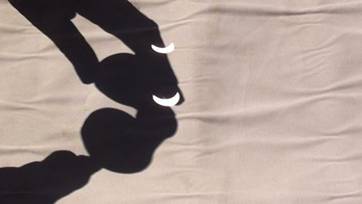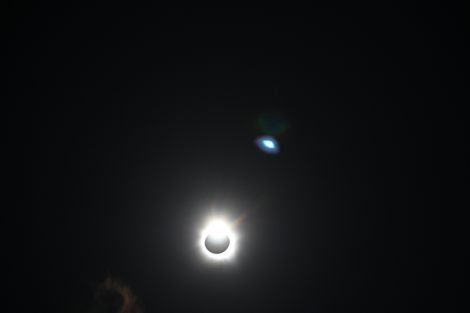Eclectic Ecliptic

Wednesday 14 November, On passage to New Zealand South Pacific Ocean 30 17.5S 172 18.1E Today’s Blog by Peter (Time zone GMT+11.00; UTC +11.00) Twas a bright cloudless sunny morning, I hesitate to say warm, particularly when - shortly after 8 o’clock - the sun was turned off and it suddenly got very cold. For us this was not a surprise as it marked the culmination of much planning, trawling through NASA websites for times and co-ordinates and 18,000 miles sailing to get here (well at least a bit of a diversion as some Yellow Brick watchers have already pointed out). Yes, we were directly under the path of the only total solar eclipse of 2012. There was one earlier in the year California way but that was only an annular eclipse (see below). So we intended to be here; we planned it and actually got here and arrived in time to prepare heaving to in order to provide the crew with the best view. Much to our surprise, it was accompanied by a pretty much cloudless sky. We felt privileged, no – lucky. That said though, we need to get our next lottery tickets bought by the yacht (Sarah Jane II) which pitched up nearby with about 30 minutes to go and who answered our radio call of “So you are here to see the eclipse too?” with “What eclipse?”, “What here! ??, Now ??” Lucky, lucky people! An eclipse occurs when the moon passes directly between the earth and the sun. It usually passes above or below in its monthly journey round the earth but two or three times a year it goes through the middle. The sun and moon, though very different distances from the earth, look about the same size in the sky. The moon’s distance varies from the earth. If it is further away, it doesn’t quite cover the sun (causing an ‘annular eclipse’ where the sun remains visible around the edge of the moon), while if it is nearer the sun can be totally obscured – as it was today. The limits of totality (complete obstruction) are very small – this time a ribbon only 60 miles wide but stretching right across the Pacific Ocean, clipping the top of Australia but not making any other landfall. Outside of this ribbon a partial eclipse was visible over most of the Sothern Hemisphere between West Australia and the east coast of South America. The chart plotter picture below shows some of the planning lines which we used to get us into the right place at the right time. (The Island on left is Norfolk Island – the little grey wedge on our bow is the AIS signal from Sarah Jean II).
It is always dangerous to look directly at the sun so indirect means need to be used …
Binoculars casting an image of the partial coverage Sextant, which is designed for star sights Failing that, and far more practical, special glasses for solar viewing were kindly supplied by Terry.
No captions by the scribe – you will have to imagine you own And finally, about an hour after “first contact”, a sudden chill arrived and a dark shadow raced towards us from the north west. As it grew dark, the sun’s corona was revealed. (Nav lights left off so as not to confuse Sarah Jean II)
A couple of minutes later the sun re-appeared, as a classic ‘diamond ring’ (with Venus top right) before the partial phase reversed.
An hour later all was back to normal. Well, nearly normal since we had taken the opportunity, whilst ‘heaved to’, to prepare now eat a cooked breakfast. We also have some “Once in a lifetime” memories. In one word – “AWESOME”. |







